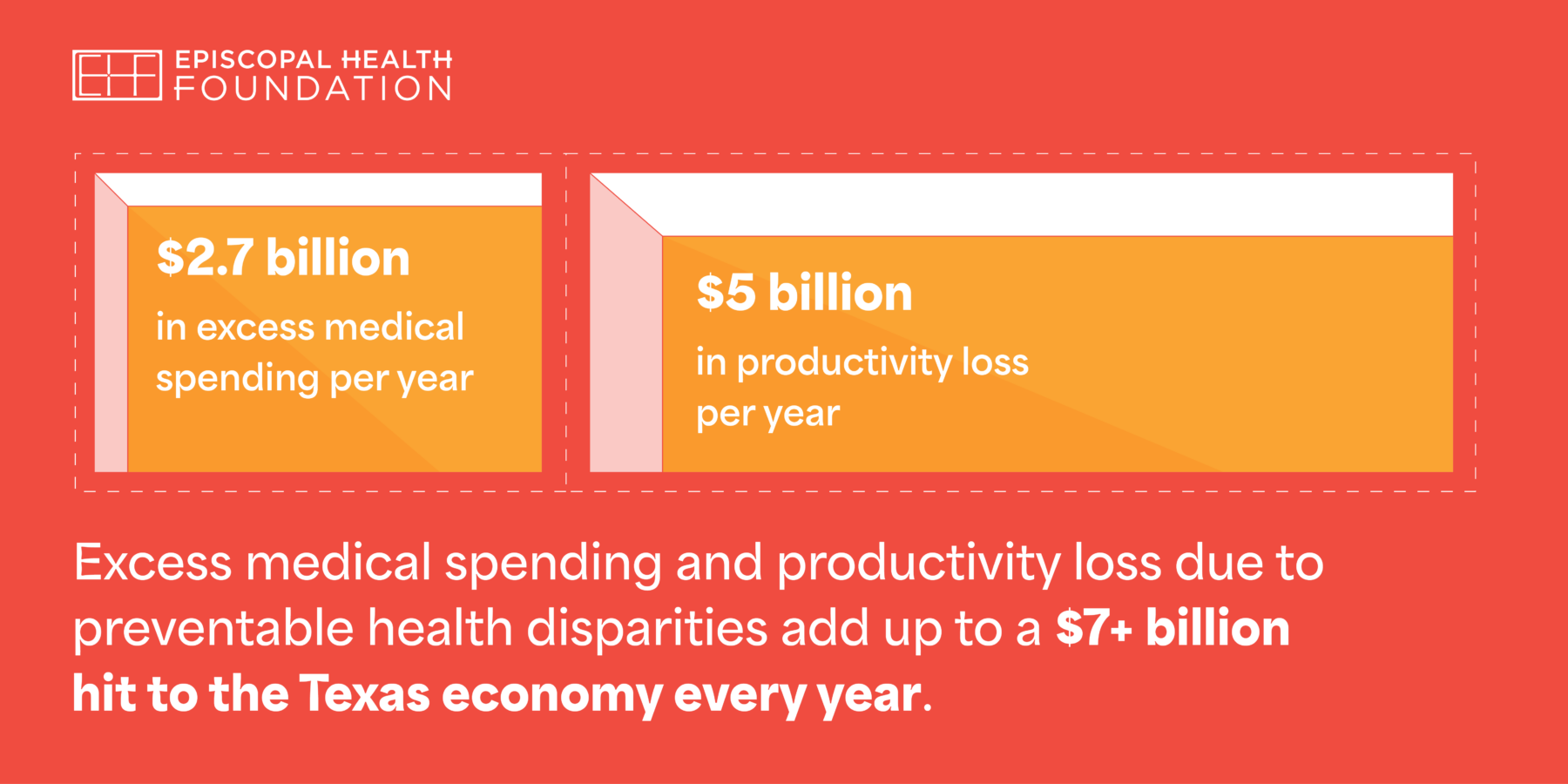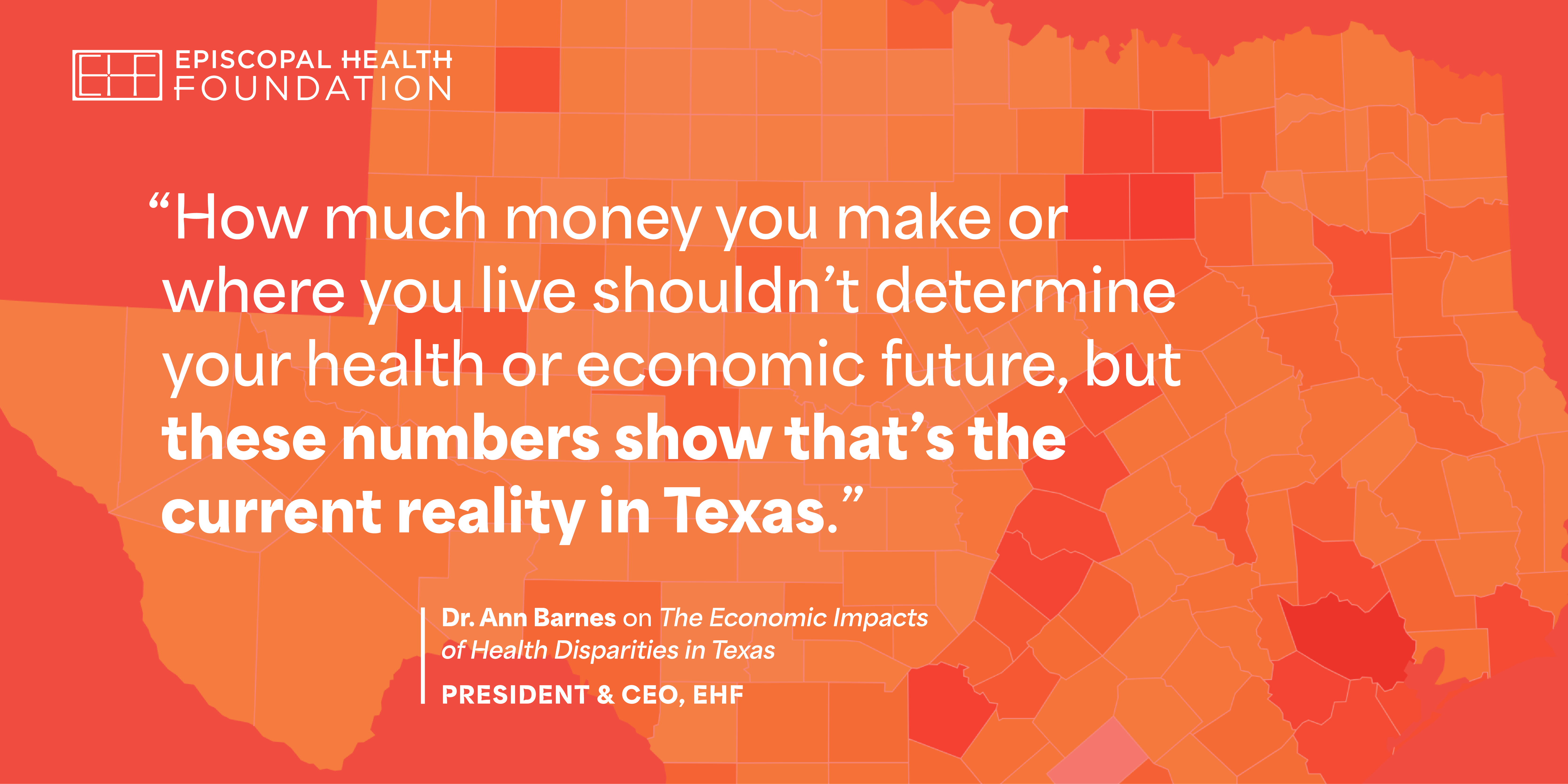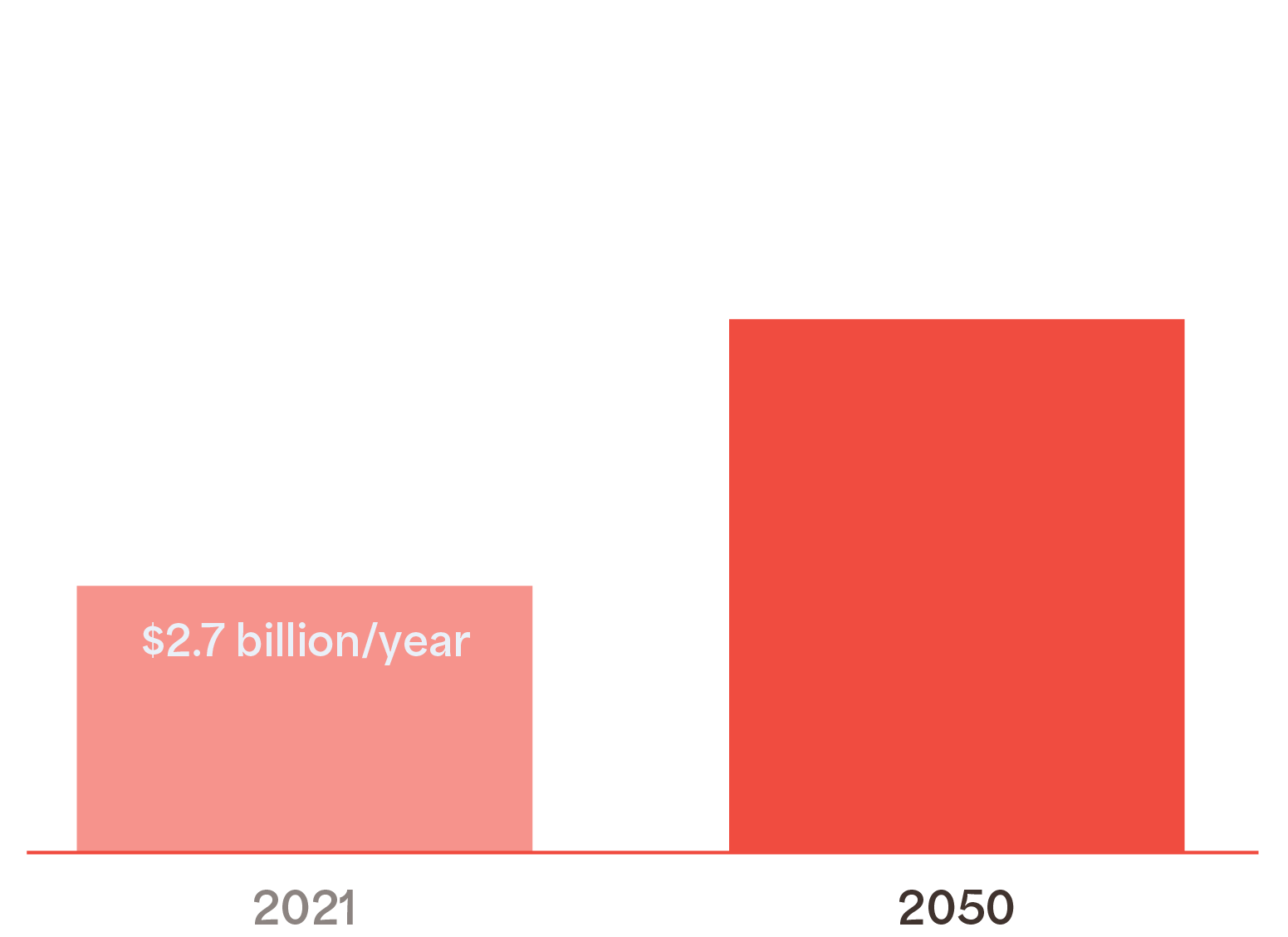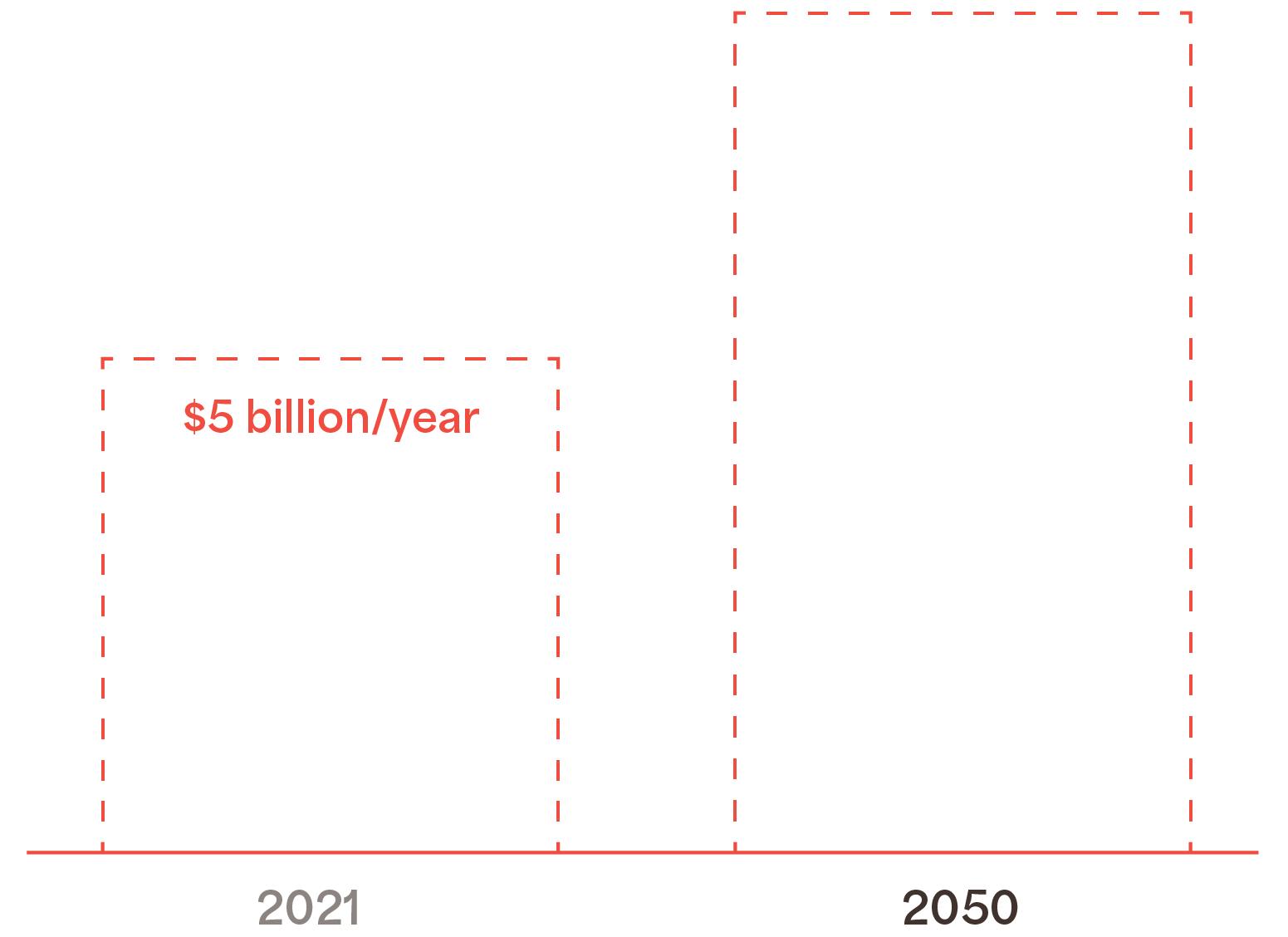Those are the findings of a report examining the overall economic impact associated with health disparities across the state and estimates the cost burden for all 254 counties in Texas. Episcopal Health Foundation, Methodist Healthcare Ministries of South Texas, and St. David’s Foundation sponsored the report.
The Economic Impacts of Health Disparities in Texas report conducted by researchers at Altarum found preventable health differences for people of color and those with lower incomes in Texas. Black and Hispanic children are more likely to grow up in neighborhoods with high poverty levels, and families with lower incomes are less likely to say they’re in good health, more likely to be uninsured, and have higher rates of diabetes and obesity.
“The bottom line – if everyone in Texas had the same opportunities for good health as the healthiest among us, our economy could potentially save billions of dollars in unnecessary costs and lost work productivity,” says Dr. Ann Barnes, EHF’s president and CEO. “Those would be staggering cost savings for the entire state.”
The report underscores that those preventable health differences not only result in worse health outcomes for Texans who face the most barriers to good health, but the disparities cost families, employers, insurers, and governments an estimated $2.7 billion in excess medical spending for hospital care, doctor services, and prescription drugs across the state.
The report also found that health disparities dramatically reduce work productivity. Researchers estimate that the annual price tag for lost work productivity in Texas is $5 billion and growing.
Together, the report concludes that excess medical spending and lost work productivity due to preventable health disparities add up to a $7+ billion hit to the Texas economy every year.
Unpacking the Economic Impact
Barnes says it’s helpful to consider how health disparities translate into financial burdens for families, businesses, government entities, and many others:
- Families face increased out-of-pocket expenses for hospital stays, doctor visits, and medications. At the same time, they make less money when they miss time at work or lose their job altogether.
- Employers bear costs from lost productivity, increased costs to replace sick employees who miss work, and higher health insurance premiums.
- State and local governments see escalated health care spending for programs like Medicaid or health departments, higher costs to cover indigent care, as well as lost tax revenue from decreased worker output.
“That’s why addressing these health disparities could alleviate financial pressures not just on the health system but also across the broader Texas economy,” Barnes explains.
County-by-County Impacts
For the first time, the report analyzes the economic costs of preventable health differences for every Texas county to highlight local cost estimates of the burden of health disparities. For each county, the online report includes an interactive map showing specific statistics for excess health care spending, lost work productivity, life years lost, and the economic costs of years lost.
Some key findings include:
- Combining excess health care spending and work productivity impacts, estimates of the annual impact of health disparities range from under $1 million per year for 66 smaller rural counties to more than $100 million per year for 13 large metropolitan counties.
- Researchers estimate that preventable health differences cost Harris County taxpayers more than $1.6 billion in excess medical spending and lost work productivity annually.
- After Harris County, Dallas, Bexar, Tarrant and Travis counties face the largest health disparity-related economic costs in the state.
- When the economic costs of health disparities are broken down by costs per resident, researchers estimate that Jefferson County in southeast Texas (population less than 260,000) faces the highest economic burden. The report says preventable health differences in Jefferson County led to $372 in per-capita costs.
- Per-capita costs for health disparities were high in urban areas like Dallas ($359) and Harris ($336) counties, but also significant in rural areas like Frio ($319), Waller ($314), and Walker ($289) counties.
“The size of each type of economic impact depended on the racial and ethnic composition of the county population and the relative size of the working age population,” said Ani Turner, co-author of the report. “Breaking the costs down by county and region helps Texas communities better understand and motivate action.”
Top 20 Counties by Per Capita Health Spending and Productivity Impact
The Price of Inaction
The report found that the economic impact of health and socioeconomic differences are expected to increase as Texas’ population grows and people of color become a larger share of the total population. Two-thirds of the 7 million children in Texas today are children of color, and half are Hispanic.
By 2050, if current disparities in health and life expectancy remain, researchers say the economic burden of health disparities will rise by more than 80%. They estimate excess medical care spending will double to $5.4 billion per year and the annual productivity loss will be $8.5 billion. That adds up to a projected $13.9 billion hit to the future state economy.
“If we do nothing, people will only get sicker and the costs to all of us will only get higher,” Barnes says. “To break the cycle of unequal, but preventable, health differences for certain groups of Texans, we have to fundamentally change how we address health outside the doctor’s office.”
Potential Solutions
Barnes says to bridge the gap in health differences across Texas, the health system and policy makers not only need to create opportunities for more affordable access to medical care, but also address non-medical factors outside the health care system that significantly influence a person’s health and well-being.
Barnes says four areas to create opportunities to reduce health disparities in Texas include:
- Increasing access to affordable health insurance coverage: By broadening the accessibility of affordable health insurance options – including Medicaid, Affordable Care Act plans, or by another state-specific project – we can ensure that more Texans have the insurance coverage they need to get preventive care and address health issues promptly.
- Investing in under-resourced neighborhoods: Channeling resources into underserved areas that increase access to affordable nutritious food and create safe recreational spaces are one way to improve healthy living options that promote better overall community health.
- Build upon recent policy changes at all levels that promote health equity: A recent Texas legislative effort extended Medicaid health insurance for 12 months to new moms. Other legislation allowed Medicaid to pay for important maternal health services by community health workers and doulas. Both are examples of policy improvements that positively affect millions of Texans. Simple yet effective changes at local levels, such as the addition of sidewalks and safer pedestrian areas, can also make a considerable difference in daily physical activity levels and community well-being.
- Collaborating for change: Improving health, not just health care, calls for a collaborative effort among policymakers, community leaders, health care providers, businesses, and many more Texans.
Episcopal Health Foundation is working to tackle the inequitable health realities faced by Texans through a new Strategic Framework that doubles down on the foundation’s efforts to address non-medical factors impacting health and now targets food/nutrition security, maternal health, and diabetes prevention as new priorities.




